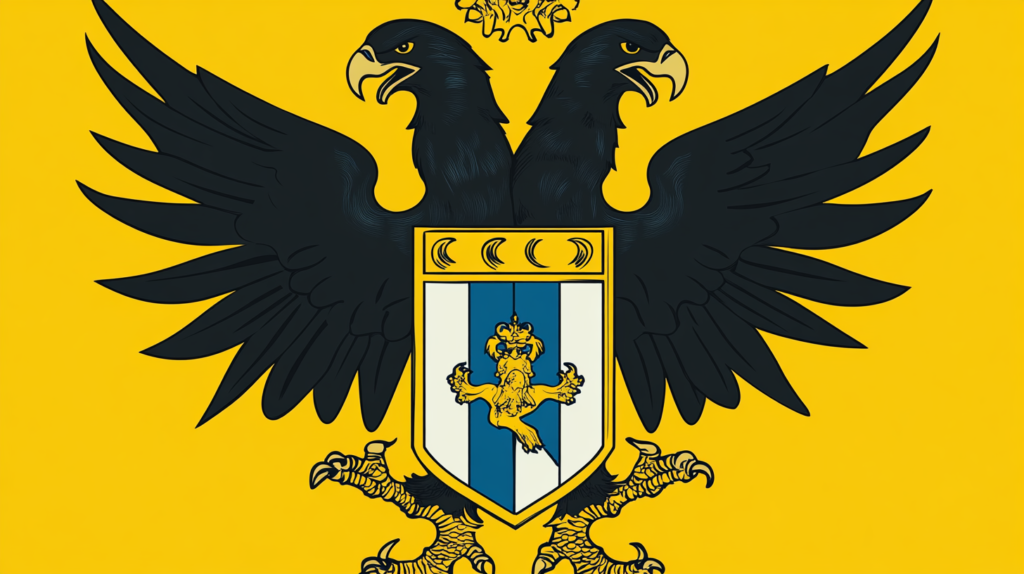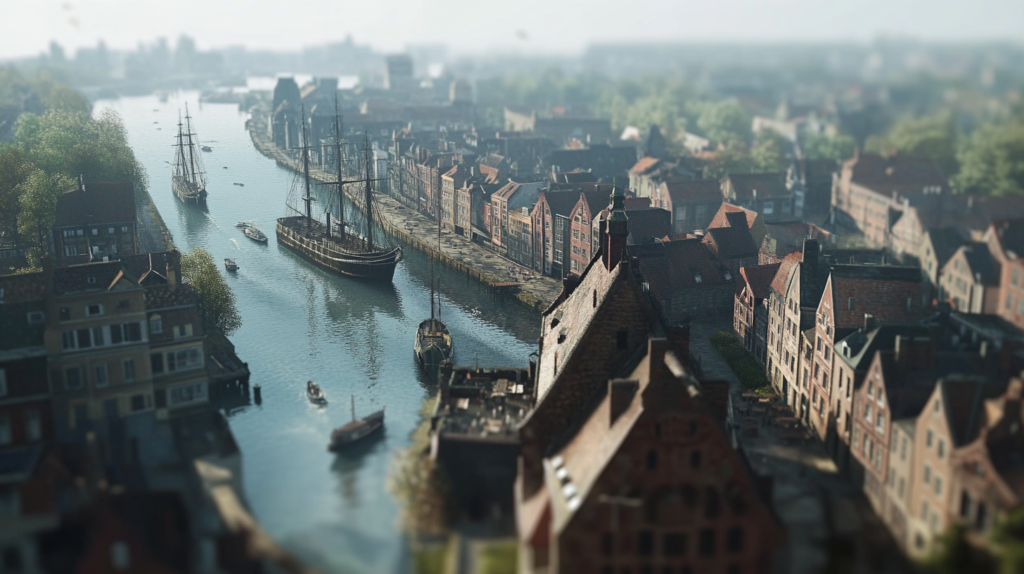
Lübeck Coat of Arms:
- The coat of arms features a black double-headed eagle (Doppeladler) with red talons and beak, set against a golden background. On the eagle’s chest is a shield divided into silver (white) and red, known as the “Lübische Schild” (Lübeck shield).
- In the greater coat of arms, the shield is held by two golden lions, and a helmet with a single-headed black eagle as a crest is placed above the shield. The helmet is adorned with silver and red mantling.
Historical Significance:
- The Double-Headed Eagle:
- The black double-headed eagle is a symbol of the Holy Roman Empire and represents Lübeck’s status as a free imperial city (Reichsstadt). Lübeck gained this status in 1226, which granted it significant autonomy and privileges.
- The eagle emphasizes Lübeck’s imperial connection and its role as a leading city in the Hanseatic League, the powerful medieval trading alliance.
- The Lübeck Shield (lübische Schild):
- The silver and red divided shield is one of the oldest symbols of Lübeck. It is believed to represent the colors of the Holy Roman Empire (white and red), rather than the colors of the Counts of Holstein, who originally founded the city.
- The shield first appeared on a ship’s seal in 1280, where it was depicted on a flag flying from a mast. By the 14th century, it became a prominent symbol of the city.
- Combination of the Eagle and Shield:
- By the 15th century, the two symbols—the double-headed eagle and the lübische Schild—were combined into a single coat of arms, with the shield placed on the eagle’s chest. This combination has been used ever since.
Evolution of the Coat of Arms:
- The earliest evidence of Lübeck’s heraldry dates back to a ship’s seal from 1280, which featured a divided flag (likely in white and red) on a mast.
- The double-headed eagle first appeared on coins in the early 14th century, symbolizing Lübeck’s imperial status.
- By the 15th century, the two symbols were combined, creating the iconic design still used today.
Symbolism of the Greater Coat of Arms:
- The two golden lions holding the shield represent strength and sovereignty.
- The helmet with a single-headed black eagle as a crest further emphasizes Lübeck’s imperial connection and its status as a free city.
- The silver and red mantling (decorative cloth) around the helmet reflects the colors of the Lübeck shield.
Historical Context of Lübeck:
- Lübeck was founded in 1143 by Adolf II of Schauenburg, but it was refounded in 1159 by Henry the Lion, Duke of Saxony and Bavaria.
- In 1226, Lübeck became a free imperial city, granting it independence from local nobility and direct allegiance to the Holy Roman Emperor.
- Lübeck rose to prominence as the head of the Hanseatic League, a powerful trading network that dominated Baltic and North Sea trade during the Middle Ages.
- Even after the decline of the Hanseatic League, Lübeck remained an important city. It was a sovereign state within the German Confederation and later the German Empire until 1937, when it was incorporated into Prussia under the Greater Hamburg Act.
Modern Significance:
- Lübeck’s coat of arms continues to symbolize its historical importance as a free imperial city and the leading city of the Hanseatic League.
- The city is known for its well-preserved medieval architecture, including the Holstentor (Holsten Gate), which prominently displays the city’s coat of arms.
- Lübeck remains a cultural and historical hub in northern Germany, and its coat of arms is a proud reminder of its imperial and Hanseatic heritage.
Summary of Key Elements:
Golden Lions and Helmet: Represent strength, sovereignty, and imperial privilege.
Double-Headed Eagle: Represents Lübeck’s status as a free imperial city and its connection to the Holy Roman Empire.
Lübeck Shield (silver and red): Symbolizes the city’s imperial colors and its historical independence.

The Hanseatic City of Lübeck
Lübeck, a city in northern Germany on the Baltic Sea, was founded in 1143 by Adolf II, Count of Schauenburg and Holstein. It quickly rose to prominence as a major trading center and became a leading member of the Hanseatic League, a medieval commercial and defensive confederation of merchant guilds and market towns. Lübeck’s strategic location on the Trave River, where it meets the Baltic Sea, made it a vital link in the trade routes connecting the Baltic region with the North Sea and beyond. The city’s access to both the Baltic and North Seas allowed it to control trade in the region, leading to its rapid growth and prosperity.
The Hanseatic League, flourishing from the 13th to the 17th century, was instrumental in shaping the economic and political landscape of Northern Europe. It was a powerful alliance of trading cities that dominated maritime trade in the Baltic and North Seas for centuries. Lübeck, as the “Queen of the Hanse,” played a pivotal role in the League’s governance and trade activities. The city’s wealth and influence grew during this period, evident in its impressive architecture and thriving cultural scene. Lübeck’s merchants traveled extensively, establishing trading posts in major cities throughout Northern Europe, and the city became a hub for the exchange of goods, ideas, and culture.
Lübeck’s historic city center, a UNESCO World Heritage Site since 1987, is a testament to its rich Hanseatic past. The city’s well-preserved medieval architecture, including the iconic Holsten Gate, the magnificent Marienkirche, and the imposing Rathaus, reflects its prosperity and influence during the Hanseatic era. The Holsten Gate, a 15th-century fortified gate, has become a symbol of Lübeck, representing the city’s strength and resilience. It served as both a defensive structure and a symbol of the city’s power and authority. The Marienkirche, a Gothic brick church, was once the largest church in the Hanseatic League, showcasing the city’s religious and architectural prowess. Its towering spires and intricate brickwork are a testament to the skill of medieval craftsmen. The Rathaus, or city hall, is a masterpiece of Gothic architecture, reflecting the city’s political and administrative importance. Its elaborate façade and grand halls served as a meeting place for the city’s leaders and a symbol of its civic pride.
Today, Lübeck is a vibrant city that cherishes its Hanseatic legacy. It is home to several museums, theaters, and art galleries, as well as a variety of shops and restaurants. The city’s annual events, such as the Schleswig-Holstein Musik Festival and the Travemünder Woche sailing regatta, attract visitors from around the world. Lübeck’s unique blend of history, culture, and maritime heritage makes it a captivating destination for travelers seeking to experience the legacy of the Hanseatic League and explore the treasures of a medieval city.
Top Draws in Lübeck
Lübeck, often called the “Queen of the Hanseatic League,” is a UNESCO World Heritage Site brimming with history, culture, and charm. Here are its top three most captivating attractions:
- Lübeck Old Town (Altstadt) and Holstentor: The heart of Lübeck’s historical allure, the Old Town is a masterpiece of medieval architecture, encircled by the Trave River and dominated by the iconic Holstentor (Holsten Gate), a 15th-century brick Gothic gatehouse symbolizing the city’s Hanseatic past. This UNESCO-listed area features cobblestone streets, red-brick churches like the Marienkirche (St. Mary’s Church) with its towering spires, and the Rathaus (Town Hall), a stunning example of North German Gothic architecture. Exploring the Old Town’s narrow alleys, markets, and museums—such as the European Hansemuseum—offers an immersive dive into Lübeck’s maritime and cultural legacy.
- Buddenbrook House: Located in the Old Town, this 18th-century patrician house is a literary landmark, once home to the Mann family, including Nobel Prize-winning author Thomas Mann. Now a museum, it explores the family’s history, Mann’s works like Buddenbrooks, and Lübeck’s intellectual heritage. Its elegant interior, period furnishings, and exhibits provide a deep cultural experience, appealing to literature lovers and history enthusiasts alike, especially given Lübeck’s nickname, “City of the Poets.”
- Travemünde Beach and Lighthouse: Lübeck’s Baltic Sea district, Travemünde, offers a stunning coastal contrast to the city’s medieval core. The wide, sandy beach stretches along the Trave River’s mouth, ideal for swimming, sunbathing, or walks along the promenade. The historic Travemünde Lighthouse, built in 1539 and expanded in 1807, offers panoramic views of the Baltic Sea, harbor, and Priwall Peninsula. The area’s maritime festivals, like the Travemünde Week (a major sailing regatta), and its blend of nature and history make it a must-visit for seaside relaxation and nautical enthusiasts.
Bonus tip – slightly off the beaten path
St. Anne’s Museum Quarter (Museumskirche St. Annen)
- Tucked just off the main tourist trail, this former convent-turned-museum is a quiet stunner. The Gothic architecture alone is worth it—think vaulted ceilings and serene cloisters—but the real kicker is the quirky mix inside: medieval art, eerie wooden altarpieces, and a modern twist with rotating exhibits (sometimes local photography or oddball installations). Entry’s about €8, and it’s got a peaceful courtyard where you can sip a coffee from the nearby café scene. It’s not as loud as Holstentor, but it’s a hidden layer of Lübeck’s history and charm—perfect for a blog’s “little extra.”